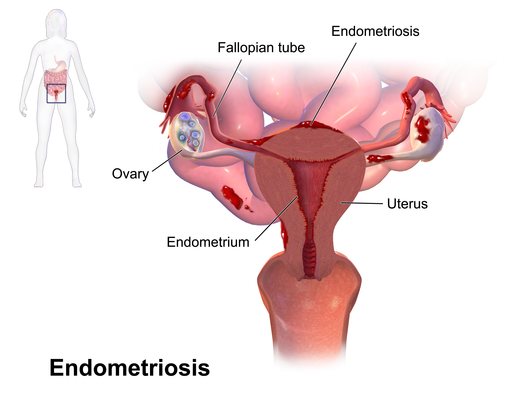(Read about one woman's experience with the disease in "What I Wish Everyone Knew About Endometriosis.")
As some recent news reports have pointed out, though, there may be new hope on the horizon for understanding endometriosis.
 |
| Illustration of endometriosis. Source: BruceBlaus, Wikimedia Commons. |
Endometriosis sufferers can face years or even decades of pelvic pain, inflammation, infertility, and a search for relief. The endometrial tissue can grow in areas like the ovaries, Fallopian tubes, outer surface of the uterus, and pelvic cavity lining. The tissue can form scarring that can cause adhesions between surfaces like the bladder and bowel.
With endometriosis, patients can experience a range of agonizing and potentially embarrassing problems, from pain during sex to extremely painful menstrual cramps, back pain, painful urination or bowel movements, and constipation or diarrhea.
To make the situation even more frustrating, researchers don't understand exactly what the causes of endometriosis are. And patients and even doctors may be reluctant to talk about it.
But as a recent New Yorker article notes, in recent years there's been news of an interesting collaboration that may shed important light on the origins of the disease (the article is well worth reading for its explanation of endometriosis and the issues involved in understanding its causes and treating it).
Linda Griffith, a biological engineer at M.I.T. (who has undergone a number of operations to treat her endometriosis), has teamed up with Keith Isaacson, a gynecologist and surgeon at Newton Wellesley Hospital Center (who has performed some of those procedures on Griffith), and the two are working to find some answers.
A few years ago they were named co-directors of a new institution for studying gynecological disorders, the M.I.T. Center for Gynopathology Research. The Center's website says that it "brings new frontiers of engineering to bear on understanding the basic biology, physiology, and pathophysiology of the female reproductive tract, in collaboration with biologists and clinicians."
In an M.I.T. video, "New Insight to Endometriosis Through Tissue Engineering and Systems Biology," Griffith notes that in all women, bits of the uterine lining spread to the abdominal cavity during their menstrual cycle. So why does this cause problems in approximately 10% of women? This is one of the key questions the Center is examining.
As the New Yorker article notes, several months ago Griffith, Isaacson, and other authors published a paper that "analyzed how a whole network of cells and molecules interacts in some patients to cause inflammation, which triggers pain and may also spur the disease’s progression. They also identified ways in which new drugs might someday help to quiet that signalling."
Find out more about the M.I.T. Center for Gynopathology Research's current investigations here, which include endometriosis, adenomyosis, and infertility.
To find more information on endometriosis:
* Daily Strength endomeriosis support group
* Endometriosis Foundation of America
* Endometriosis.org
* From the Mayo Clinic: endometriosis symptoms, risk factors, complications, and treatments
* FAQs about endometriosis from Endometriosis.org
No comments:
Post a Comment